Critical Appraisal of Qualitative Research on ICU Nursing Strategies
VerifiedAdded on 2022/10/17
|8
|2289
|13
Report
AI Summary
This report presents a critical appraisal of a qualitative research article that explores nursing communication strategies with family members of ICU patients. The appraisal utilizes the CASP (Critical Appraisal Skills Programme) tool, evaluating various aspects of the research including aims, methodology, research design, recruitment strategy, data collection, ethical considerations, data analysis, findings, and the overall value of the research. The report identifies both strengths, such as the clear statement of aims and the use of qualitative methodology, and weaknesses, including a lack of a clear research question, limitations in the sample size, and insufficient ethical considerations. The analysis highlights the importance of rigorous data analysis, credibility testing, and the need for broader applicability of research findings in nursing practice. The report concludes that while the CASP tool effectively analyzed the research, further research is needed to bring the findings into nursing practice.
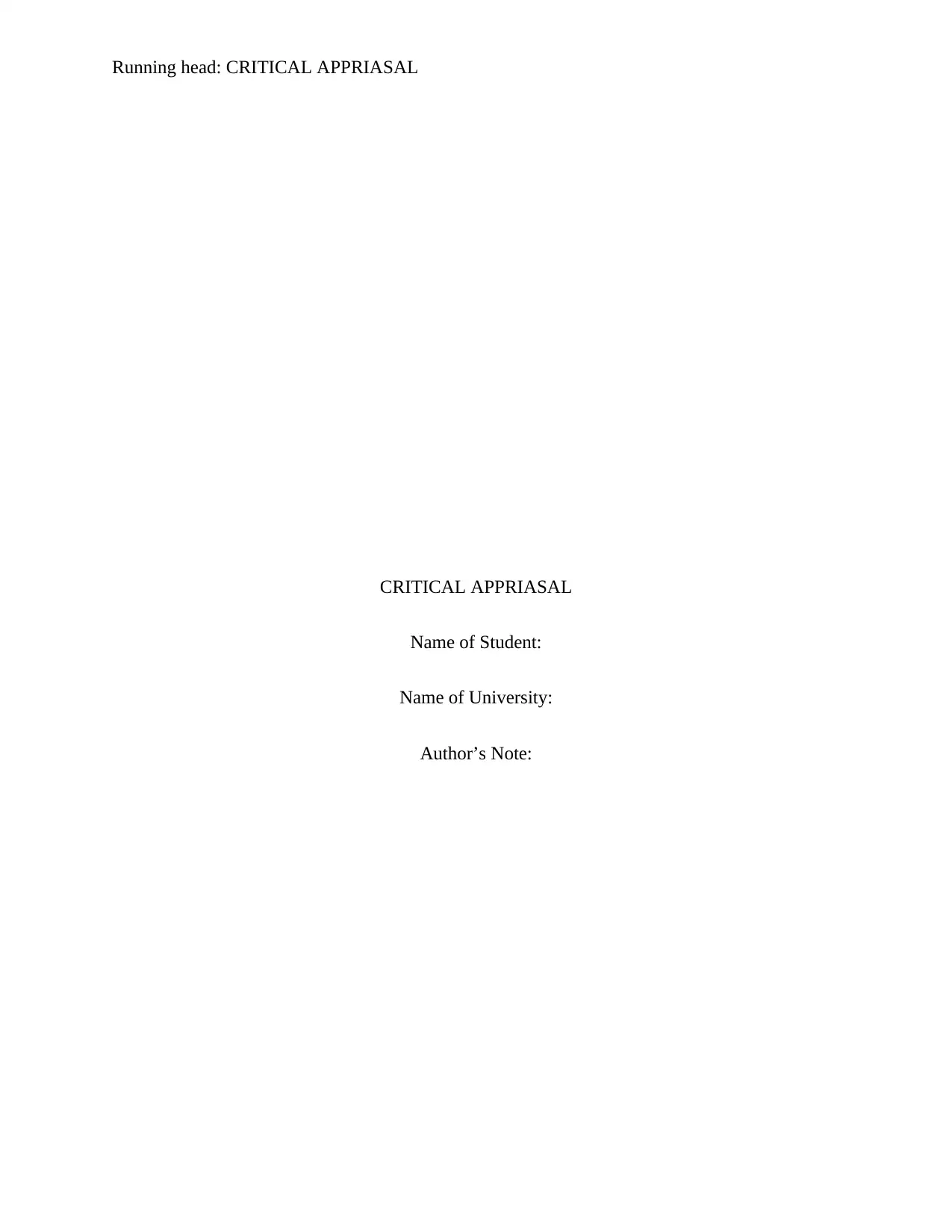
Running head: CRITICAL APPRIASAL
CRITICAL APPRIASAL
Name of Student:
Name of University:
Author’s Note:
CRITICAL APPRIASAL
Name of Student:
Name of University:
Author’s Note:
Secure Best Marks with AI Grader
Need help grading? Try our AI Grader for instant feedback on your assignments.
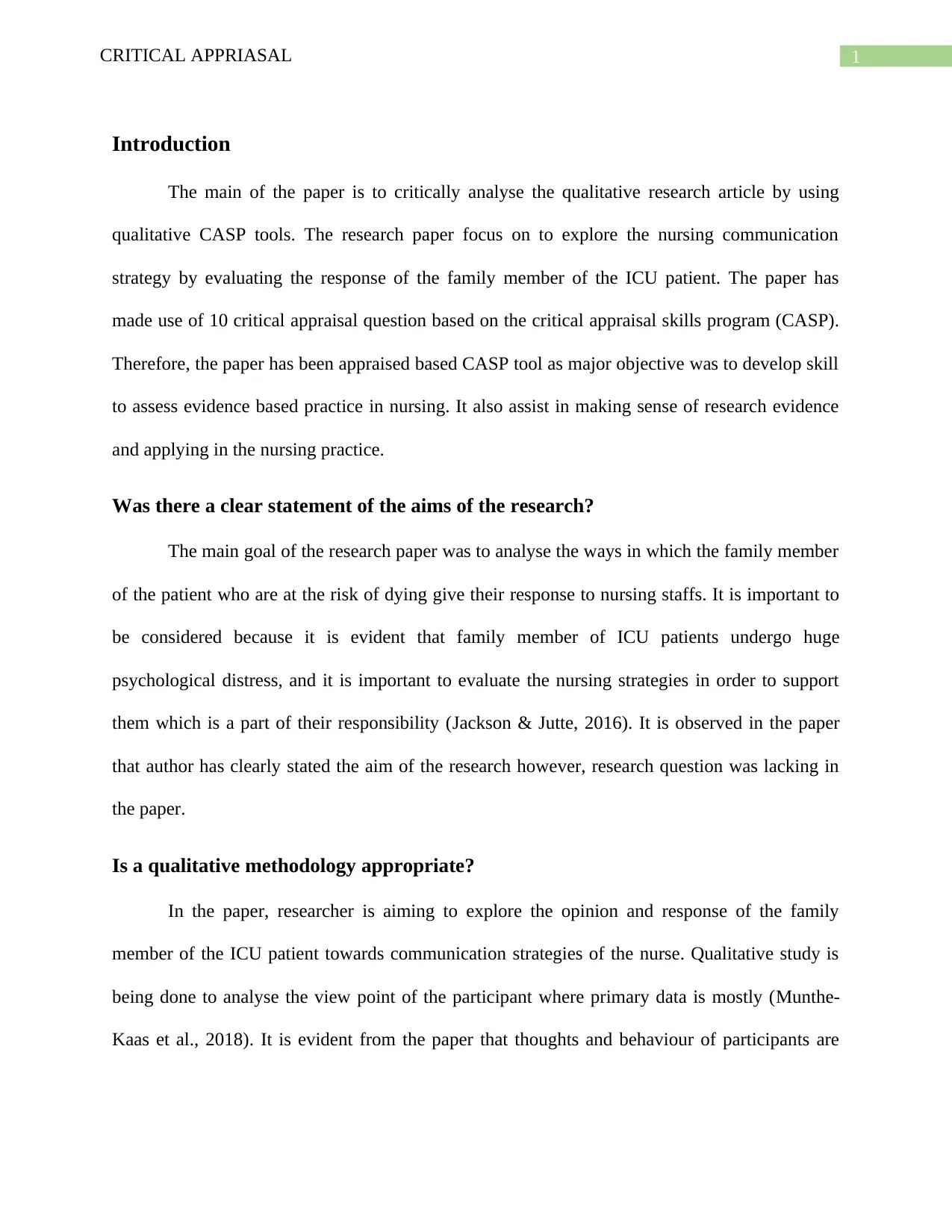
1CRITICAL APPRIASAL
Introduction
The main of the paper is to critically analyse the qualitative research article by using
qualitative CASP tools. The research paper focus on to explore the nursing communication
strategy by evaluating the response of the family member of the ICU patient. The paper has
made use of 10 critical appraisal question based on the critical appraisal skills program (CASP).
Therefore, the paper has been appraised based CASP tool as major objective was to develop skill
to assess evidence based practice in nursing. It also assist in making sense of research evidence
and applying in the nursing practice.
Was there a clear statement of the aims of the research?
The main goal of the research paper was to analyse the ways in which the family member
of the patient who are at the risk of dying give their response to nursing staffs. It is important to
be considered because it is evident that family member of ICU patients undergo huge
psychological distress, and it is important to evaluate the nursing strategies in order to support
them which is a part of their responsibility (Jackson & Jutte, 2016). It is observed in the paper
that author has clearly stated the aim of the research however, research question was lacking in
the paper.
Is a qualitative methodology appropriate?
In the paper, researcher is aiming to explore the opinion and response of the family
member of the ICU patient towards communication strategies of the nurse. Qualitative study is
being done to analyse the view point of the participant where primary data is mostly (Munthe-
Kaas et al., 2018). It is evident from the paper that thoughts and behaviour of participants are
Introduction
The main of the paper is to critically analyse the qualitative research article by using
qualitative CASP tools. The research paper focus on to explore the nursing communication
strategy by evaluating the response of the family member of the ICU patient. The paper has
made use of 10 critical appraisal question based on the critical appraisal skills program (CASP).
Therefore, the paper has been appraised based CASP tool as major objective was to develop skill
to assess evidence based practice in nursing. It also assist in making sense of research evidence
and applying in the nursing practice.
Was there a clear statement of the aims of the research?
The main goal of the research paper was to analyse the ways in which the family member
of the patient who are at the risk of dying give their response to nursing staffs. It is important to
be considered because it is evident that family member of ICU patients undergo huge
psychological distress, and it is important to evaluate the nursing strategies in order to support
them which is a part of their responsibility (Jackson & Jutte, 2016). It is observed in the paper
that author has clearly stated the aim of the research however, research question was lacking in
the paper.
Is a qualitative methodology appropriate?
In the paper, researcher is aiming to explore the opinion and response of the family
member of the ICU patient towards communication strategies of the nurse. Qualitative study is
being done to analyse the view point of the participant where primary data is mostly (Munthe-
Kaas et al., 2018). It is evident from the paper that thoughts and behaviour of participants are
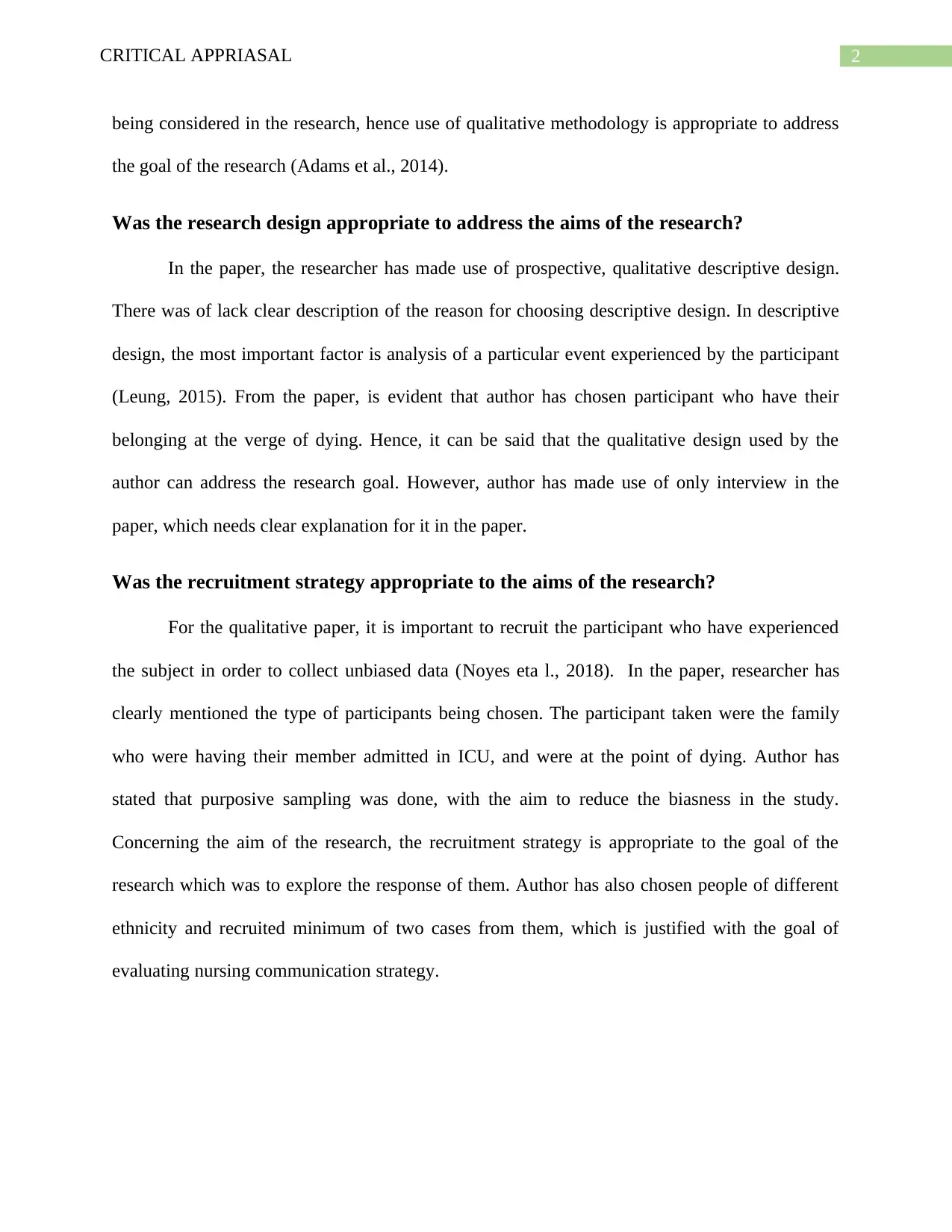
2CRITICAL APPRIASAL
being considered in the research, hence use of qualitative methodology is appropriate to address
the goal of the research (Adams et al., 2014).
Was the research design appropriate to address the aims of the research?
In the paper, the researcher has made use of prospective, qualitative descriptive design.
There was of lack clear description of the reason for choosing descriptive design. In descriptive
design, the most important factor is analysis of a particular event experienced by the participant
(Leung, 2015). From the paper, is evident that author has chosen participant who have their
belonging at the verge of dying. Hence, it can be said that the qualitative design used by the
author can address the research goal. However, author has made use of only interview in the
paper, which needs clear explanation for it in the paper.
Was the recruitment strategy appropriate to the aims of the research?
For the qualitative paper, it is important to recruit the participant who have experienced
the subject in order to collect unbiased data (Noyes eta l., 2018). In the paper, researcher has
clearly mentioned the type of participants being chosen. The participant taken were the family
who were having their member admitted in ICU, and were at the point of dying. Author has
stated that purposive sampling was done, with the aim to reduce the biasness in the study.
Concerning the aim of the research, the recruitment strategy is appropriate to the goal of the
research which was to explore the response of them. Author has also chosen people of different
ethnicity and recruited minimum of two cases from them, which is justified with the goal of
evaluating nursing communication strategy.
being considered in the research, hence use of qualitative methodology is appropriate to address
the goal of the research (Adams et al., 2014).
Was the research design appropriate to address the aims of the research?
In the paper, the researcher has made use of prospective, qualitative descriptive design.
There was of lack clear description of the reason for choosing descriptive design. In descriptive
design, the most important factor is analysis of a particular event experienced by the participant
(Leung, 2015). From the paper, is evident that author has chosen participant who have their
belonging at the verge of dying. Hence, it can be said that the qualitative design used by the
author can address the research goal. However, author has made use of only interview in the
paper, which needs clear explanation for it in the paper.
Was the recruitment strategy appropriate to the aims of the research?
For the qualitative paper, it is important to recruit the participant who have experienced
the subject in order to collect unbiased data (Noyes eta l., 2018). In the paper, researcher has
clearly mentioned the type of participants being chosen. The participant taken were the family
who were having their member admitted in ICU, and were at the point of dying. Author has
stated that purposive sampling was done, with the aim to reduce the biasness in the study.
Concerning the aim of the research, the recruitment strategy is appropriate to the goal of the
research which was to explore the response of them. Author has also chosen people of different
ethnicity and recruited minimum of two cases from them, which is justified with the goal of
evaluating nursing communication strategy.
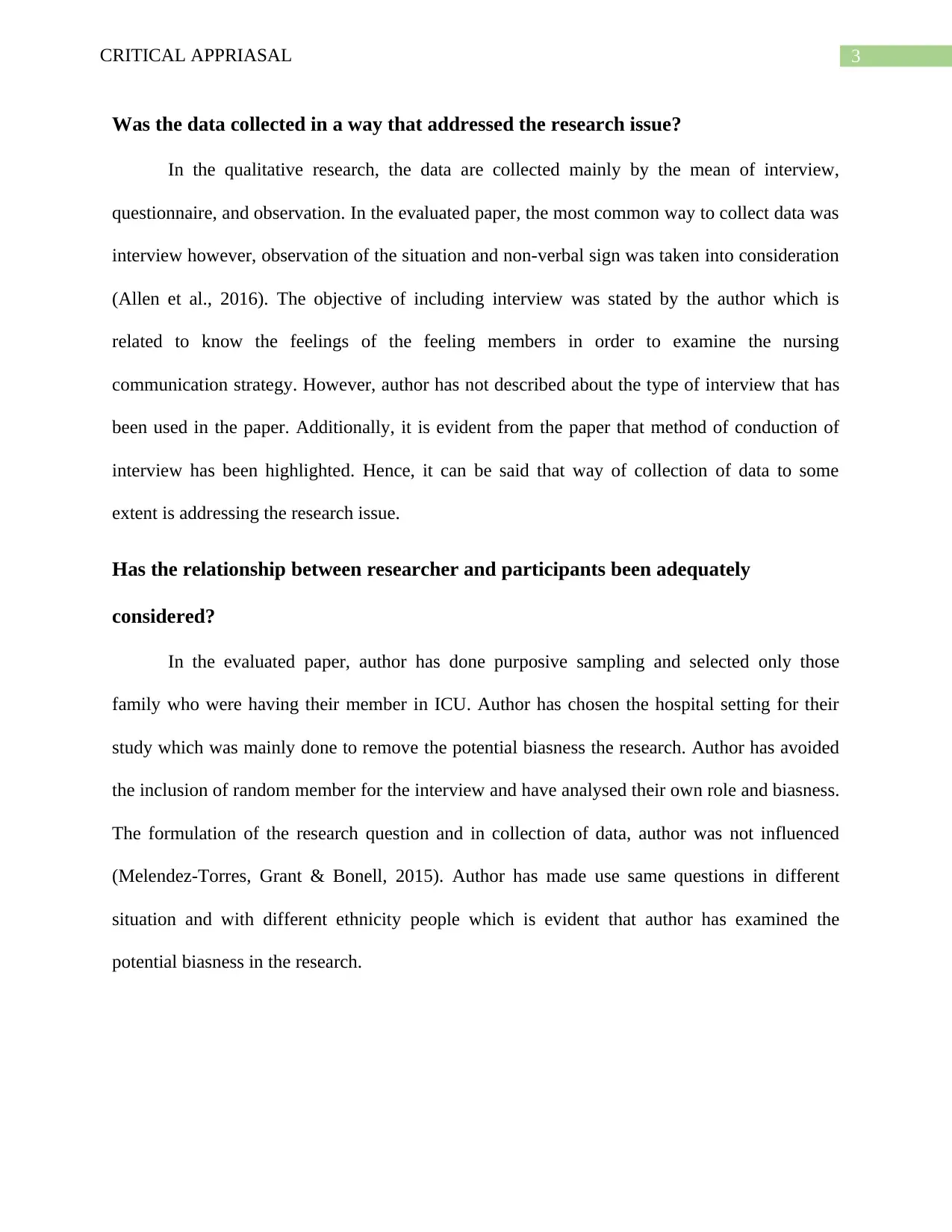
3CRITICAL APPRIASAL
Was the data collected in a way that addressed the research issue?
In the qualitative research, the data are collected mainly by the mean of interview,
questionnaire, and observation. In the evaluated paper, the most common way to collect data was
interview however, observation of the situation and non-verbal sign was taken into consideration
(Allen et al., 2016). The objective of including interview was stated by the author which is
related to know the feelings of the feeling members in order to examine the nursing
communication strategy. However, author has not described about the type of interview that has
been used in the paper. Additionally, it is evident from the paper that method of conduction of
interview has been highlighted. Hence, it can be said that way of collection of data to some
extent is addressing the research issue.
Has the relationship between researcher and participants been adequately
considered?
In the evaluated paper, author has done purposive sampling and selected only those
family who were having their member in ICU. Author has chosen the hospital setting for their
study which was mainly done to remove the potential biasness the research. Author has avoided
the inclusion of random member for the interview and have analysed their own role and biasness.
The formulation of the research question and in collection of data, author was not influenced
(Melendez‐Torres, Grant & Bonell, 2015). Author has made use same questions in different
situation and with different ethnicity people which is evident that author has examined the
potential biasness in the research.
Was the data collected in a way that addressed the research issue?
In the qualitative research, the data are collected mainly by the mean of interview,
questionnaire, and observation. In the evaluated paper, the most common way to collect data was
interview however, observation of the situation and non-verbal sign was taken into consideration
(Allen et al., 2016). The objective of including interview was stated by the author which is
related to know the feelings of the feeling members in order to examine the nursing
communication strategy. However, author has not described about the type of interview that has
been used in the paper. Additionally, it is evident from the paper that method of conduction of
interview has been highlighted. Hence, it can be said that way of collection of data to some
extent is addressing the research issue.
Has the relationship between researcher and participants been adequately
considered?
In the evaluated paper, author has done purposive sampling and selected only those
family who were having their member in ICU. Author has chosen the hospital setting for their
study which was mainly done to remove the potential biasness the research. Author has avoided
the inclusion of random member for the interview and have analysed their own role and biasness.
The formulation of the research question and in collection of data, author was not influenced
(Melendez‐Torres, Grant & Bonell, 2015). Author has made use same questions in different
situation and with different ethnicity people which is evident that author has examined the
potential biasness in the research.
Secure Best Marks with AI Grader
Need help grading? Try our AI Grader for instant feedback on your assignments.
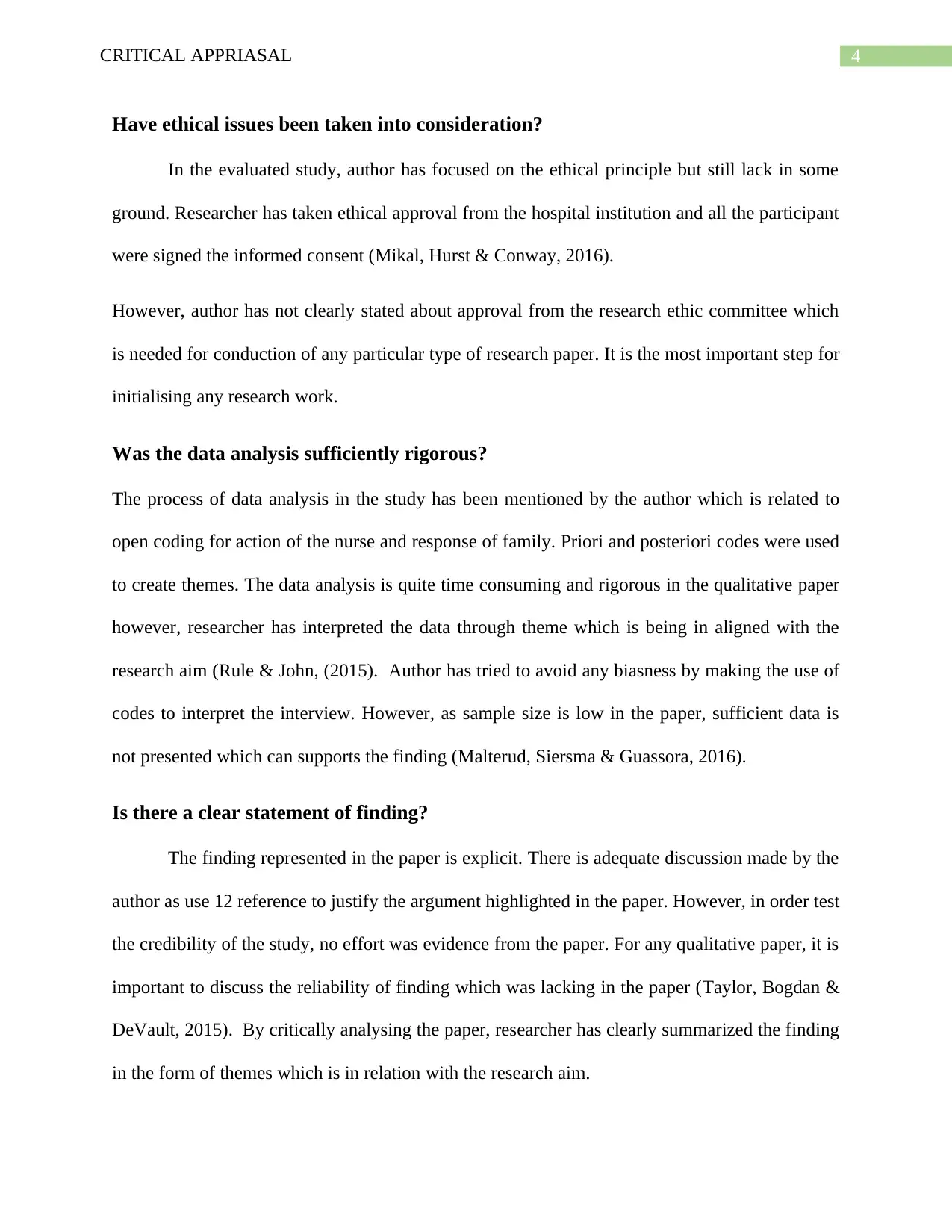
4CRITICAL APPRIASAL
Have ethical issues been taken into consideration?
In the evaluated study, author has focused on the ethical principle but still lack in some
ground. Researcher has taken ethical approval from the hospital institution and all the participant
were signed the informed consent (Mikal, Hurst & Conway, 2016).
However, author has not clearly stated about approval from the research ethic committee which
is needed for conduction of any particular type of research paper. It is the most important step for
initialising any research work.
Was the data analysis sufficiently rigorous?
The process of data analysis in the study has been mentioned by the author which is related to
open coding for action of the nurse and response of family. Priori and posteriori codes were used
to create themes. The data analysis is quite time consuming and rigorous in the qualitative paper
however, researcher has interpreted the data through theme which is being in aligned with the
research aim (Rule & John, (2015). Author has tried to avoid any biasness by making the use of
codes to interpret the interview. However, as sample size is low in the paper, sufficient data is
not presented which can supports the finding (Malterud, Siersma & Guassora, 2016).
Is there a clear statement of finding?
The finding represented in the paper is explicit. There is adequate discussion made by the
author as use 12 reference to justify the argument highlighted in the paper. However, in order test
the credibility of the study, no effort was evidence from the paper. For any qualitative paper, it is
important to discuss the reliability of finding which was lacking in the paper (Taylor, Bogdan &
DeVault, 2015). By critically analysing the paper, researcher has clearly summarized the finding
in the form of themes which is in relation with the research aim.
Have ethical issues been taken into consideration?
In the evaluated study, author has focused on the ethical principle but still lack in some
ground. Researcher has taken ethical approval from the hospital institution and all the participant
were signed the informed consent (Mikal, Hurst & Conway, 2016).
However, author has not clearly stated about approval from the research ethic committee which
is needed for conduction of any particular type of research paper. It is the most important step for
initialising any research work.
Was the data analysis sufficiently rigorous?
The process of data analysis in the study has been mentioned by the author which is related to
open coding for action of the nurse and response of family. Priori and posteriori codes were used
to create themes. The data analysis is quite time consuming and rigorous in the qualitative paper
however, researcher has interpreted the data through theme which is being in aligned with the
research aim (Rule & John, (2015). Author has tried to avoid any biasness by making the use of
codes to interpret the interview. However, as sample size is low in the paper, sufficient data is
not presented which can supports the finding (Malterud, Siersma & Guassora, 2016).
Is there a clear statement of finding?
The finding represented in the paper is explicit. There is adequate discussion made by the
author as use 12 reference to justify the argument highlighted in the paper. However, in order test
the credibility of the study, no effort was evidence from the paper. For any qualitative paper, it is
important to discuss the reliability of finding which was lacking in the paper (Taylor, Bogdan &
DeVault, 2015). By critically analysing the paper, researcher has clearly summarized the finding
in the form of themes which is in relation with the research aim.
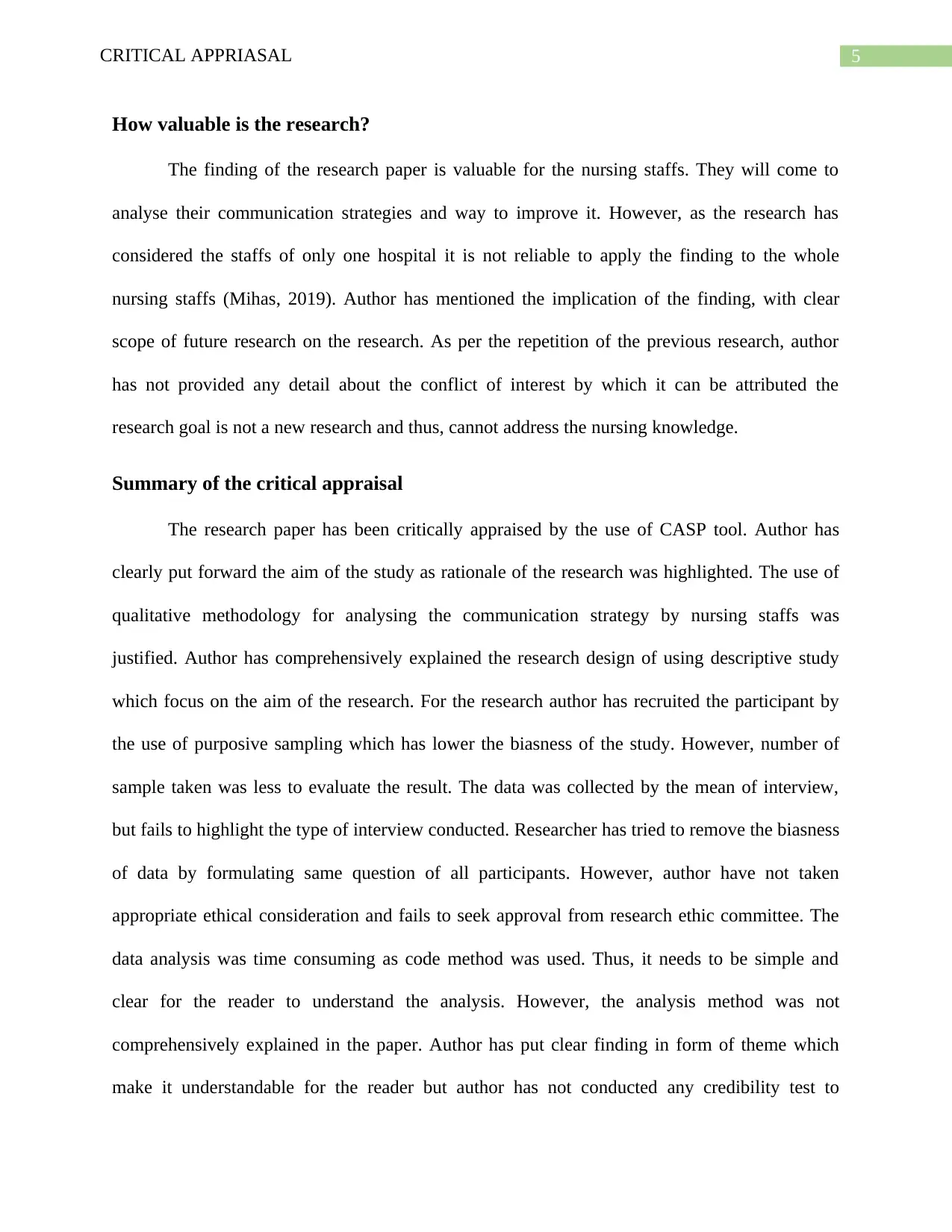
5CRITICAL APPRIASAL
How valuable is the research?
The finding of the research paper is valuable for the nursing staffs. They will come to
analyse their communication strategies and way to improve it. However, as the research has
considered the staffs of only one hospital it is not reliable to apply the finding to the whole
nursing staffs (Mihas, 2019). Author has mentioned the implication of the finding, with clear
scope of future research on the research. As per the repetition of the previous research, author
has not provided any detail about the conflict of interest by which it can be attributed the
research goal is not a new research and thus, cannot address the nursing knowledge.
Summary of the critical appraisal
The research paper has been critically appraised by the use of CASP tool. Author has
clearly put forward the aim of the study as rationale of the research was highlighted. The use of
qualitative methodology for analysing the communication strategy by nursing staffs was
justified. Author has comprehensively explained the research design of using descriptive study
which focus on the aim of the research. For the research author has recruited the participant by
the use of purposive sampling which has lower the biasness of the study. However, number of
sample taken was less to evaluate the result. The data was collected by the mean of interview,
but fails to highlight the type of interview conducted. Researcher has tried to remove the biasness
of data by formulating same question of all participants. However, author have not taken
appropriate ethical consideration and fails to seek approval from research ethic committee. The
data analysis was time consuming as code method was used. Thus, it needs to be simple and
clear for the reader to understand the analysis. However, the analysis method was not
comprehensively explained in the paper. Author has put clear finding in form of theme which
make it understandable for the reader but author has not conducted any credibility test to
How valuable is the research?
The finding of the research paper is valuable for the nursing staffs. They will come to
analyse their communication strategies and way to improve it. However, as the research has
considered the staffs of only one hospital it is not reliable to apply the finding to the whole
nursing staffs (Mihas, 2019). Author has mentioned the implication of the finding, with clear
scope of future research on the research. As per the repetition of the previous research, author
has not provided any detail about the conflict of interest by which it can be attributed the
research goal is not a new research and thus, cannot address the nursing knowledge.
Summary of the critical appraisal
The research paper has been critically appraised by the use of CASP tool. Author has
clearly put forward the aim of the study as rationale of the research was highlighted. The use of
qualitative methodology for analysing the communication strategy by nursing staffs was
justified. Author has comprehensively explained the research design of using descriptive study
which focus on the aim of the research. For the research author has recruited the participant by
the use of purposive sampling which has lower the biasness of the study. However, number of
sample taken was less to evaluate the result. The data was collected by the mean of interview,
but fails to highlight the type of interview conducted. Researcher has tried to remove the biasness
of data by formulating same question of all participants. However, author have not taken
appropriate ethical consideration and fails to seek approval from research ethic committee. The
data analysis was time consuming as code method was used. Thus, it needs to be simple and
clear for the reader to understand the analysis. However, the analysis method was not
comprehensively explained in the paper. Author has put clear finding in form of theme which
make it understandable for the reader but author has not conducted any credibility test to
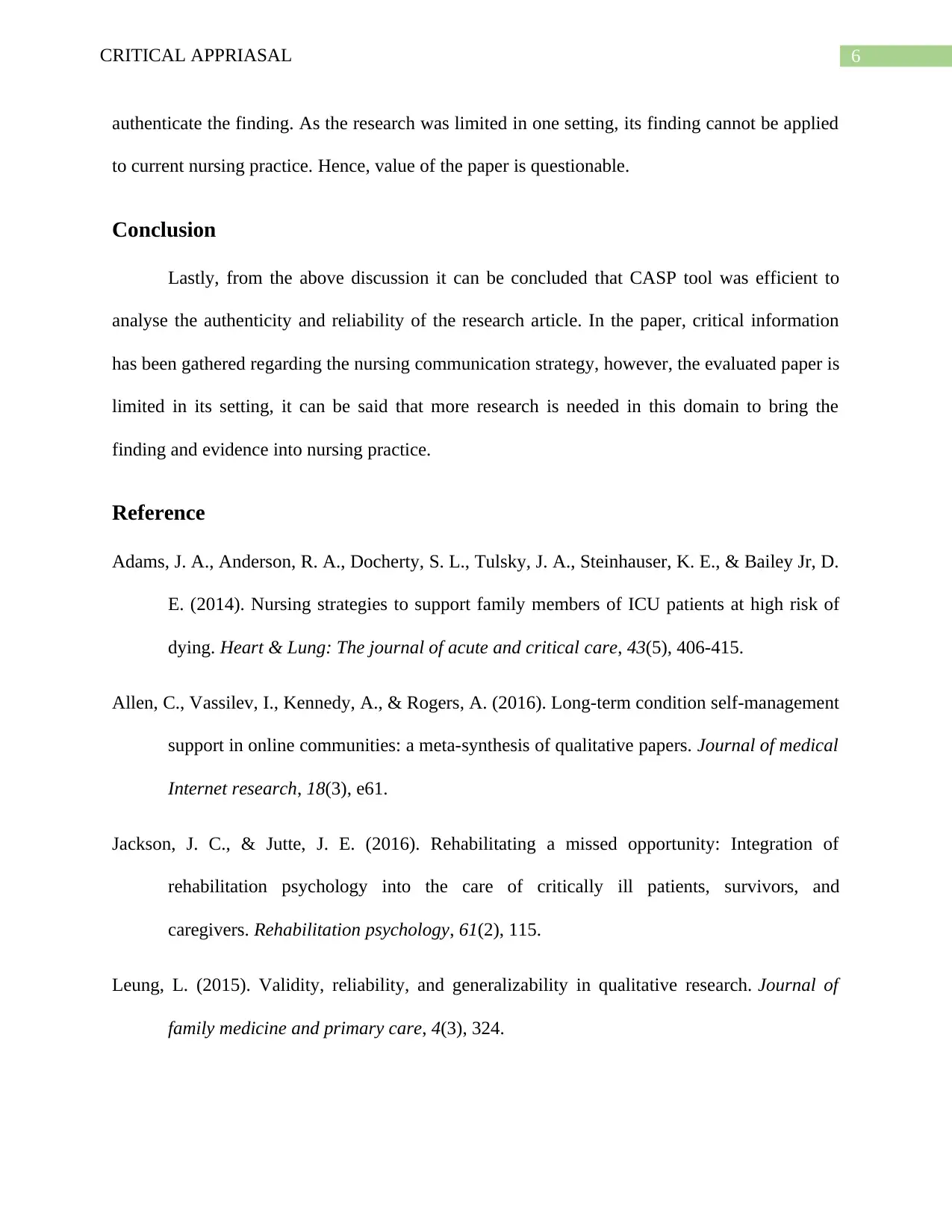
6CRITICAL APPRIASAL
authenticate the finding. As the research was limited in one setting, its finding cannot be applied
to current nursing practice. Hence, value of the paper is questionable.
Conclusion
Lastly, from the above discussion it can be concluded that CASP tool was efficient to
analyse the authenticity and reliability of the research article. In the paper, critical information
has been gathered regarding the nursing communication strategy, however, the evaluated paper is
limited in its setting, it can be said that more research is needed in this domain to bring the
finding and evidence into nursing practice.
Reference
Adams, J. A., Anderson, R. A., Docherty, S. L., Tulsky, J. A., Steinhauser, K. E., & Bailey Jr, D.
E. (2014). Nursing strategies to support family members of ICU patients at high risk of
dying. Heart & Lung: The journal of acute and critical care, 43(5), 406-415.
Allen, C., Vassilev, I., Kennedy, A., & Rogers, A. (2016). Long-term condition self-management
support in online communities: a meta-synthesis of qualitative papers. Journal of medical
Internet research, 18(3), e61.
Jackson, J. C., & Jutte, J. E. (2016). Rehabilitating a missed opportunity: Integration of
rehabilitation psychology into the care of critically ill patients, survivors, and
caregivers. Rehabilitation psychology, 61(2), 115.
Leung, L. (2015). Validity, reliability, and generalizability in qualitative research. Journal of
family medicine and primary care, 4(3), 324.
authenticate the finding. As the research was limited in one setting, its finding cannot be applied
to current nursing practice. Hence, value of the paper is questionable.
Conclusion
Lastly, from the above discussion it can be concluded that CASP tool was efficient to
analyse the authenticity and reliability of the research article. In the paper, critical information
has been gathered regarding the nursing communication strategy, however, the evaluated paper is
limited in its setting, it can be said that more research is needed in this domain to bring the
finding and evidence into nursing practice.
Reference
Adams, J. A., Anderson, R. A., Docherty, S. L., Tulsky, J. A., Steinhauser, K. E., & Bailey Jr, D.
E. (2014). Nursing strategies to support family members of ICU patients at high risk of
dying. Heart & Lung: The journal of acute and critical care, 43(5), 406-415.
Allen, C., Vassilev, I., Kennedy, A., & Rogers, A. (2016). Long-term condition self-management
support in online communities: a meta-synthesis of qualitative papers. Journal of medical
Internet research, 18(3), e61.
Jackson, J. C., & Jutte, J. E. (2016). Rehabilitating a missed opportunity: Integration of
rehabilitation psychology into the care of critically ill patients, survivors, and
caregivers. Rehabilitation psychology, 61(2), 115.
Leung, L. (2015). Validity, reliability, and generalizability in qualitative research. Journal of
family medicine and primary care, 4(3), 324.
Paraphrase This Document
Need a fresh take? Get an instant paraphrase of this document with our AI Paraphraser
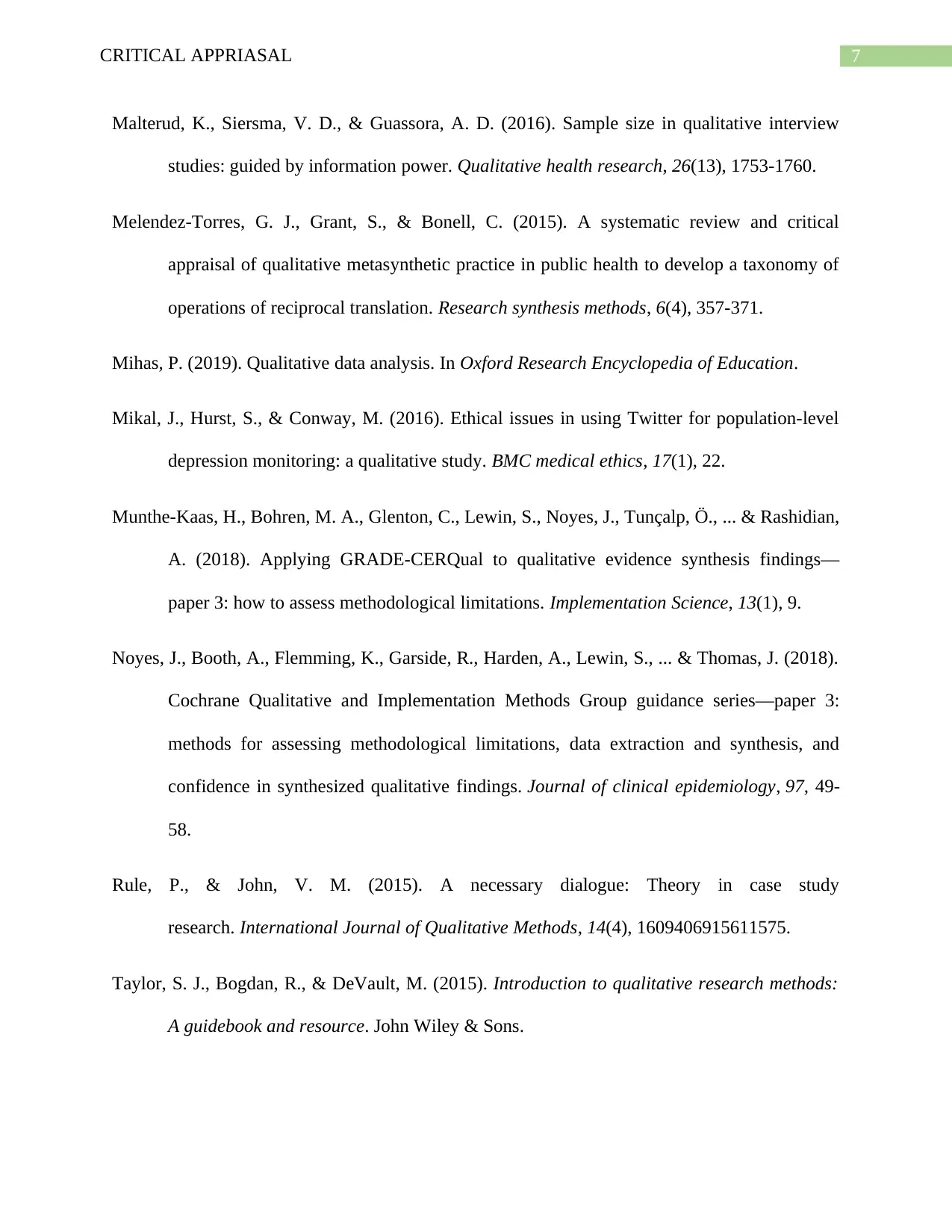
7CRITICAL APPRIASAL
Malterud, K., Siersma, V. D., & Guassora, A. D. (2016). Sample size in qualitative interview
studies: guided by information power. Qualitative health research, 26(13), 1753-1760.
Melendez‐Torres, G. J., Grant, S., & Bonell, C. (2015). A systematic review and critical
appraisal of qualitative metasynthetic practice in public health to develop a taxonomy of
operations of reciprocal translation. Research synthesis methods, 6(4), 357-371.
Mihas, P. (2019). Qualitative data analysis. In Oxford Research Encyclopedia of Education.
Mikal, J., Hurst, S., & Conway, M. (2016). Ethical issues in using Twitter for population-level
depression monitoring: a qualitative study. BMC medical ethics, 17(1), 22.
Munthe-Kaas, H., Bohren, M. A., Glenton, C., Lewin, S., Noyes, J., Tunçalp, Ö., ... & Rashidian,
A. (2018). Applying GRADE-CERQual to qualitative evidence synthesis findings—
paper 3: how to assess methodological limitations. Implementation Science, 13(1), 9.
Noyes, J., Booth, A., Flemming, K., Garside, R., Harden, A., Lewin, S., ... & Thomas, J. (2018).
Cochrane Qualitative and Implementation Methods Group guidance series—paper 3:
methods for assessing methodological limitations, data extraction and synthesis, and
confidence in synthesized qualitative findings. Journal of clinical epidemiology, 97, 49-
58.
Rule, P., & John, V. M. (2015). A necessary dialogue: Theory in case study
research. International Journal of Qualitative Methods, 14(4), 1609406915611575.
Taylor, S. J., Bogdan, R., & DeVault, M. (2015). Introduction to qualitative research methods:
A guidebook and resource. John Wiley & Sons.
Malterud, K., Siersma, V. D., & Guassora, A. D. (2016). Sample size in qualitative interview
studies: guided by information power. Qualitative health research, 26(13), 1753-1760.
Melendez‐Torres, G. J., Grant, S., & Bonell, C. (2015). A systematic review and critical
appraisal of qualitative metasynthetic practice in public health to develop a taxonomy of
operations of reciprocal translation. Research synthesis methods, 6(4), 357-371.
Mihas, P. (2019). Qualitative data analysis. In Oxford Research Encyclopedia of Education.
Mikal, J., Hurst, S., & Conway, M. (2016). Ethical issues in using Twitter for population-level
depression monitoring: a qualitative study. BMC medical ethics, 17(1), 22.
Munthe-Kaas, H., Bohren, M. A., Glenton, C., Lewin, S., Noyes, J., Tunçalp, Ö., ... & Rashidian,
A. (2018). Applying GRADE-CERQual to qualitative evidence synthesis findings—
paper 3: how to assess methodological limitations. Implementation Science, 13(1), 9.
Noyes, J., Booth, A., Flemming, K., Garside, R., Harden, A., Lewin, S., ... & Thomas, J. (2018).
Cochrane Qualitative and Implementation Methods Group guidance series—paper 3:
methods for assessing methodological limitations, data extraction and synthesis, and
confidence in synthesized qualitative findings. Journal of clinical epidemiology, 97, 49-
58.
Rule, P., & John, V. M. (2015). A necessary dialogue: Theory in case study
research. International Journal of Qualitative Methods, 14(4), 1609406915611575.
Taylor, S. J., Bogdan, R., & DeVault, M. (2015). Introduction to qualitative research methods:
A guidebook and resource. John Wiley & Sons.
1 out of 8
Related Documents
Your All-in-One AI-Powered Toolkit for Academic Success.
+13062052269
info@desklib.com
Available 24*7 on WhatsApp / Email
![[object Object]](/_next/static/media/star-bottom.7253800d.svg)
Unlock your academic potential
© 2024 | Zucol Services PVT LTD | All rights reserved.




